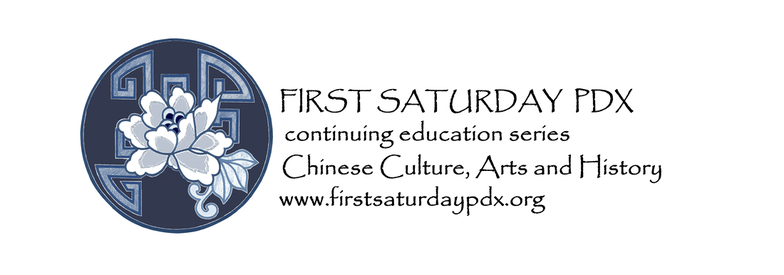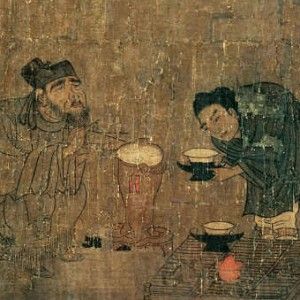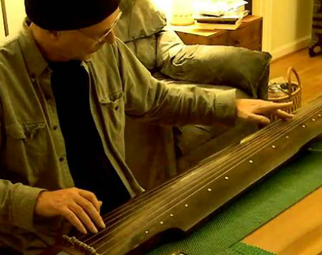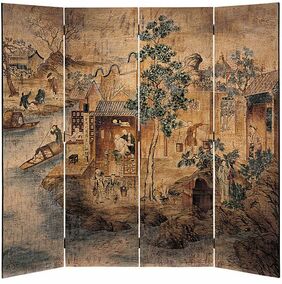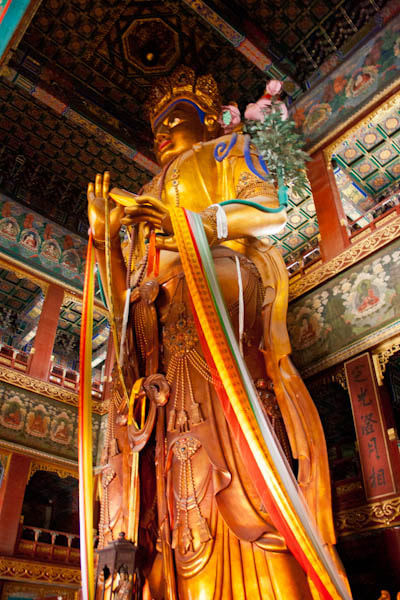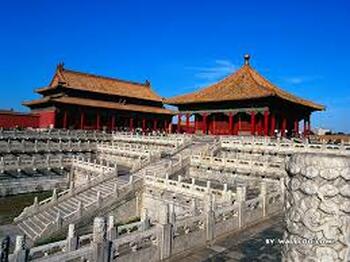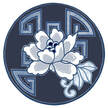
2012 – 2013 Season
Insights Along the Zigzag Bridge
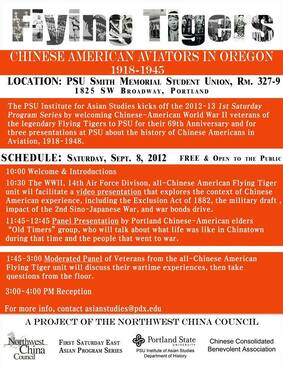
Flying Tigers
September 8, 2012
We welcome a panel of Chinese – American Word War II veterans from the legendary Flying Tigers for their 69th Anniversary who will be on hand to discuss their wartime experiences after a video presentation that explores the context of the Chinese American experience, including the Exclusion Act of 1882, the military draft, impact of the 2nd Sino – Japanese War and war bonds drive. An additional panel presentation will be of the Portland Chinese – American elders “Old Timers” group who will talk about what life was like in Chinatown during that time and the people who when to war
September 8, 2012
We welcome a panel of Chinese – American Word War II veterans from the legendary Flying Tigers for their 69th Anniversary who will be on hand to discuss their wartime experiences after a video presentation that explores the context of the Chinese American experience, including the Exclusion Act of 1882, the military draft, impact of the 2nd Sino – Japanese War and war bonds drive. An additional panel presentation will be of the Portland Chinese – American elders “Old Timers” group who will talk about what life was like in Chinatown during that time and the people who when to war
|
Pu’er: From Plant to Cup
Claudia Duncan October 6, 2012 Discover why the ancient Chinese tradition of drinking and sharing fragrant tea with friends and strangers continues today. Learn about the Tea Horse Road as we travel with Claudia Duncan of the Tao of Tea, who will provide an introduction and colorful history of tea bricks, in particular pu’er from Yunnan Province. This aromatic tea, noted for its health benefits, has an ancient history of trade and tribute within China, to Tibet and Mongolia, and to Europe and the world. Learn about its various types, and see how they are prepared and served. |
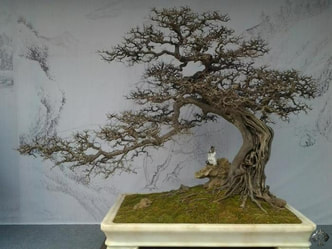
Penjing Beautiful: Living 3-Dimensional Poetry
Mark Vossbrink
November 8, 2012
Penjing is an ancient cultural art embraced by the Chinese literati for connecting to nature. It reflects the love and respect for nature as it seeks to express the kind of special atmosphere emanating from Chinese classical paintings and poetry, often a philosophical idea, principle, or concept. A precursor to Japanese bonsai and Korean bonsai namu, penjing is not confined by rigid rules or patterns, but is more free spirited and strives to represent natural landscape by creating miniature container-grown trees or landscape groupings in small trays for small spaces. Mark Vossbrink, our local penjing expert, provides a brief historical discourse of this joyful hobby and fascinating art form using images, specimens, and an interactive demonstration.
Mark Vossbrink
November 8, 2012
Penjing is an ancient cultural art embraced by the Chinese literati for connecting to nature. It reflects the love and respect for nature as it seeks to express the kind of special atmosphere emanating from Chinese classical paintings and poetry, often a philosophical idea, principle, or concept. A precursor to Japanese bonsai and Korean bonsai namu, penjing is not confined by rigid rules or patterns, but is more free spirited and strives to represent natural landscape by creating miniature container-grown trees or landscape groupings in small trays for small spaces. Mark Vossbrink, our local penjing expert, provides a brief historical discourse of this joyful hobby and fascinating art form using images, specimens, and an interactive demonstration.
|
The Qin: Abiding with Antiquity (video)
Jim Binkley December 1, 2012 The qin or “instrument of the sages” is associated with Confucius and is a plucked seven-string Chinese musical instrument, traditionally favored by scholars as an instrument of great subtlety and refinement. There are around 1,070 different finger techniques, the most in either Chinese or Western music. Professor Jim Binkley, scholar and performer of the qin in China, provides engaging explanations and demonstrations of the instrument and music. |
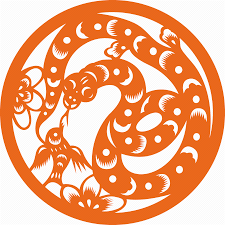
Chinese New Year Brunch:
Welcoming the Year of the Snake 蛇 , 4711
First Saturday PDX Planning Committee
January 12, 2013
|
Folding Screens of East Asia:
Multiple Scenes, Multiple Uses Charles Lachman February 2, 2013 Globalization is not a new phenomena. The interchange of knowledge, aesthetics, ideas, philosophies, world views, and culture are reflected in history. Dr. Charles Lachman, former Curator of Asian Art at the Jordan Schnitzer Museum at the University of Oregon, introduces us to the evolution of the painted folding screens of China, Japan, and Korea. Dr. Lachman examines some of the diverse pictorial traditions and practices that characterize this unique artistic format. |
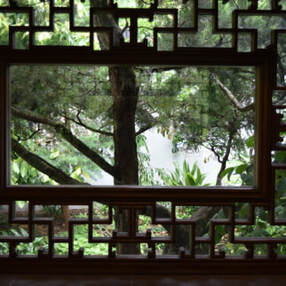
From Asphalt to Chinese Literati Garden
Ben Ngan
March 2, 2013
This program focuses on Portland’s Lan Su Chinese Garden as an example of urban renewal and the transformation of an inert asphalt parking lot into a living garden for enjoyment by people of different backgrounds. Beyond physical changes, it represents the creation of a nondescript piece of land into a place imbued with the intellect and history of a unique literati culture that transcends national boundaries to create a public inspiring retreat of subtle, sensual beauty and spirituality. Ben Ngan, landscape architect and past board member of the garden and the Chinese Classical Garden Society, shares his insights and pictorial images of the development of the garden from its original concept through construction and completion.
Ben Ngan
March 2, 2013
This program focuses on Portland’s Lan Su Chinese Garden as an example of urban renewal and the transformation of an inert asphalt parking lot into a living garden for enjoyment by people of different backgrounds. Beyond physical changes, it represents the creation of a nondescript piece of land into a place imbued with the intellect and history of a unique literati culture that transcends national boundaries to create a public inspiring retreat of subtle, sensual beauty and spirituality. Ben Ngan, landscape architect and past board member of the garden and the Chinese Classical Garden Society, shares his insights and pictorial images of the development of the garden from its original concept through construction and completion.
|
The Ideology of Power:
Architecture of the Lama Temple in Beijing Kevin Greenwood April 6, 2013 Yonghegong Monastery, the largest Tibetan Buddhist temple in Beijing, is a site with a rich and complex 300-year history. Popularly known as the “Lama Temple,” it is famous for its spectacular architecture and art, including a 60-foot high sandalwood sculpture of the Buddha of the Future and elaborate yearly ceremonies. Throughout history, Yonghegong has rich political significance. Professor Kevin Greenwood explains the complex and multilayered interplay of art, religion, and politics as reflected in the architecture as the monastery evolved from an imperial prince’s residence to a symbol of imperial universalism, and to a symbol of multicultural harmony in contemporary China. |
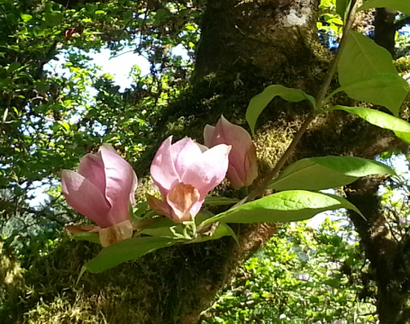
Celebrating the Beauty and Significance of the Magnolia
Martin Nicholson
May 4, 2013
“No group of trees and shrubs is more favorably known or more highly appreciated in gardens than magnolias and no group produces larger or more abundant blossoms” stated the Chinese plant explorer, Ernest Wilson, soon after the turn of the 19th century. On land once owned by the Atfalati tribe, and leveled by fire in 1889, now stands a premier collection of trees from around the world. Curator Martin Nicholson will provide an in-depth tour of Hoyt’s nationally recognized Magnolia (Chinese Jade Orchids ) collection in its myriad colors and forms.
Martin Nicholson
May 4, 2013
“No group of trees and shrubs is more favorably known or more highly appreciated in gardens than magnolias and no group produces larger or more abundant blossoms” stated the Chinese plant explorer, Ernest Wilson, soon after the turn of the 19th century. On land once owned by the Atfalati tribe, and leveled by fire in 1889, now stands a premier collection of trees from around the world. Curator Martin Nicholson will provide an in-depth tour of Hoyt’s nationally recognized Magnolia (Chinese Jade Orchids ) collection in its myriad colors and forms.
|
A City Within a City: Zijin Cheng – The Purple Forbidden City
Frances Li June 1, 2013 During the Ming and Qing Dynasties, the Imperial Palace was known as the “Purple Forbidden City.” It is recognized as the world’s largest ancient palace of 178 acres with a history of almost 600 years. Serving as a political center at the heart of Beijing, the complex exemplifies traditional Chinese palatial architecture, and has influenced cultural and architectural developments in East Asia and elsewhere. Frances Li provides a visual, historical introduction to this distinctive complex and Beijing. |
Our educational program series has been developed in collaboration with PSU’s Institute for Asian Studies, and is free and open to the public.
View our regular monthly location by clicking on the address below for directions:
Portland State University, Academic & Student Recreation Ctr (ASRC), Room 230
1800 SW 6th Ave, Portland OR 97201
Excellent MAX and bus transportation is right by the venue; plan your Trimet trip HERE. There is also a nearby parking structure at SW 6th and Harrison with an entrance on 6th Avenue is also available.
View PSU Parking info:
https://www.pdx.edu/transportation/hourly-visitor-parking
View our regular monthly location by clicking on the address below for directions:
Portland State University, Academic & Student Recreation Ctr (ASRC), Room 230
1800 SW 6th Ave, Portland OR 97201
Excellent MAX and bus transportation is right by the venue; plan your Trimet trip HERE. There is also a nearby parking structure at SW 6th and Harrison with an entrance on 6th Avenue is also available.
View PSU Parking info:
https://www.pdx.edu/transportation/hourly-visitor-parking
